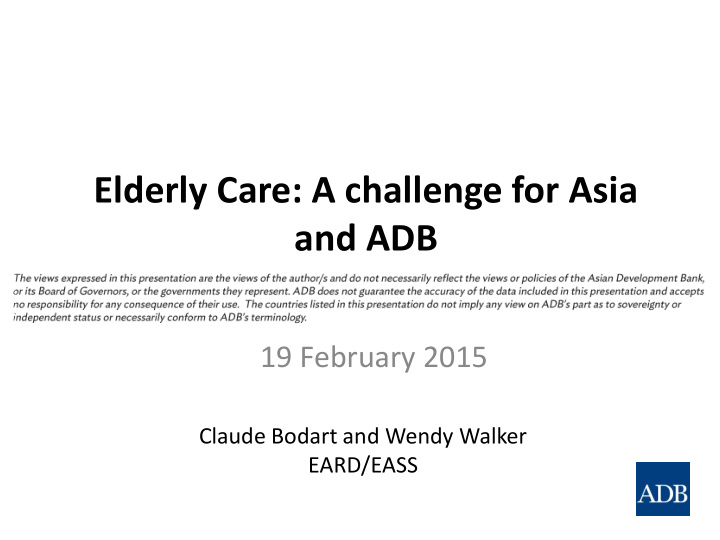



Elderly Care: A challenge for Asia and ADB 19 February 2015 Claude Bodart and Wendy Walker EARD/EASS
Aging as an Opportunity!
Aging: No Country is Spared
The Speed of Aging: always faster (Time required or expected for population aged 65 or older to increase from 7% to 14%) 1860 1880 1900 1920 1940 1960 1980 2000 2020 2040 14% Percentage of Population Aged 65+ Korea 7% Kingdomof United United States of Republic of China France Sweden Great Britain Japan Thailand Brazil America Source: Kinsella K, He W. An aging world: 2008 Washington, DC: National Institute on Aging and US Census Bureau, 2009
Asia: Limited Public Spending (Non health public social expenditures for elderly above 65) Source: OECD statistics 2012
Vulnerability • OECD countries: old-age poverty 13.3% per cent, compared with 10.6% population average • Vietnam: 17.2% elderly live in poverty (vs. avg. 6.8%). By 2050 elderly will triple from 8.9% to 30% of the population. – 40% of elderly in Vietnam are widows Four-fifths of older people do not have regular income, and millions are unable to access basic services, including transport and health, due to high cost and inadequacy of services
Elderly Care: Multifaceted Gender Inequality Men and women above statutory pensionable age receiving pension (ILO 2014) Persistent gender inequalities in access to income security in old age 58.6 49.1 50 39.1 40 34.3 Unequal physical health 31.7 29.2 30 27.5 27.5 24.3 status of the Elderly by 19.8 20 10 gender (PRC) 0 Need help Body pain Overweight Hypertension Poor with self-reported daily activities health 4 Women Men Women Source: China Health and Retirement Longitudinal Study 2012 Men 3.5 Unequal cognitive ability 3 by gender and 2.5 age group (PRC) 2 1.5 45-49 50-54 55-59 60-64 65-69 70-74 75-79 80+ Age Source: China Health and Retirement Longitudinal Study 2012
Impact of Aging on Economic Growth - Not Yet Clear - KEY: Healthy Aging + Public policy that accommodates the needs of an aging society For instance: A healthy population can reduce care needs and maintain high levels of productivity. Public policy can support employment sharing, parents living with children, age friendly public transportation, day health care services, etc. Data/Research are needed!
Addressing Elderly Care Needs is Complex • Policies and legislation • Human resources • Financing: Pensions, long term care insurance, subsidies • Care services (home/community/institutions) • Health care services • Social conditions • Infrastructure and private sector engagement • Information systems (Needs, quality of services) • Assistive technology
What Sectors of ADB are Involved? Infrastructure Governance Public Financial Urban Management development Social Protection Private Sector Civil Society Education Organizations Health Transport
Good Reasons for ADB to Engage? • Fiscal impacts of elderly care will increase and could/will become unsustainable • Huge care needs and market for investment in DMCs (private and public) • Large potential for job creation • ADB can play a role in minimizing the negative consequences of delayed policy development and investments
EARD Emerging portfolio TA Loan Human Planning Resources Integrated Service Public Social Delivery Private Sector Financial Protection Management
ADB is Unprepared to Support Governments From Spiky Silos to ……………….Multidisciplinary Teams Private sector Private sector Education Urban and rural Education development specialists Social protection Finance Leadership Governance Finance/pension specialist specialist Health Governance Social protection Health Specialist Urban and specialist rural
The Way Forward for ADB (short to midterm: 2-3 Years) 1. Make Multidisciplinary Team work 2. Set-up a Thematic Group with interested staff 3. Mobilize resources (e.g., RETA - with a full time coordinator acting as the engine of the Theme Group Secretariat)to generate knowledge and business 4. Establish Links to Centers of Excellence 5. Develop a course for ADB and government and briefing pack for Management and ADB Staff 6. Develop an Elderly Care Knowledge Hub 7. Maintain a Database (experts, experiences, lessons learned) 8. Stimulate Demand of DMCs : policy dialogue, sector assessments, business development
Recommend
More recommend